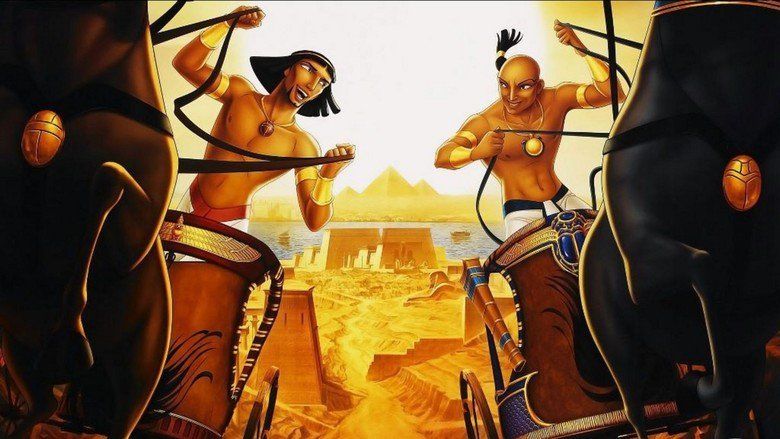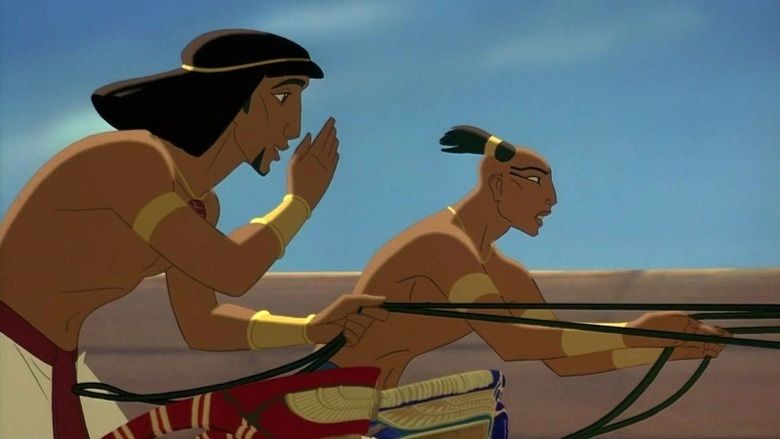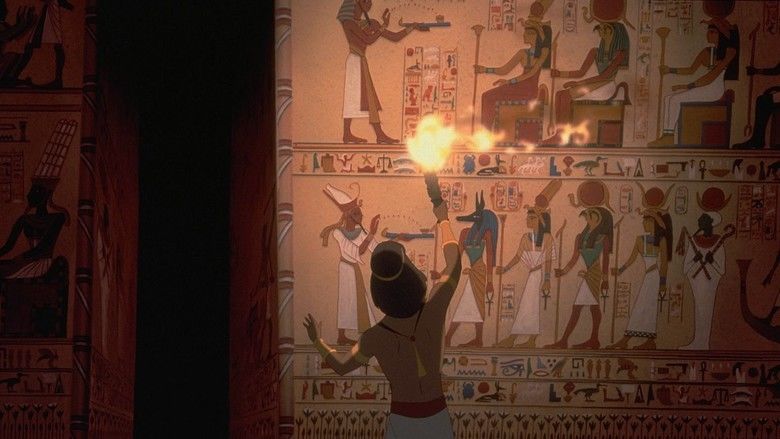The Prince of Egypt
7.6 /10 1 Votes
79% Rotten Tomatoes 64% Metacritic Genre Animation, Adventure, Drama Duration Language EnglishHebrew | 7/10 IMDb 3.5/4 Roger Ebert Country United States | |||||||||||||||||||||||||||||||||
 | ||||||||||||||||||||||||||||||||||
Director Simon WellsBrenda ChapmanSteve Hickner Release date December 16, 1998 (1998-12-16) (premiere)December 18, 1998 (1998-12-18) (United States) Songs When You Believe (from The Prince of Egypt) Cast Similar movies Raiders of the Lost Ark , Shrek the Third , DragonHeart: A New Beginning , , DuckTales: The Movie - Treasure of the Lost Lamp , The Spy Who Loved Me Tagline The Power Is Real. | ||||||||||||||||||||||||||||||||||
the prince of egypt trailer
The Prince of Egypt is a 1998 American animated epic musical and biblical drama film and the first traditional animated film produced and released by DreamWorks. The film is an adaptation of the Book of Exodus and follows the life of Moses from being a prince of Egypt to his ultimate destiny to lead the children of Israel out of Egypt. Directed by Brenda Chapman, Steve Hickner, and Simon Wells, the film features songs written by Stephen Schwartz and a score composed by Hans Zimmer. The voice cast consists of Val Kilmer in a dual role, Ralph Fiennes, Michelle Pfeiffer, Sandra Bullock, Jeff Goldblum, Danny Glover, Patrick Stewart, Helen Mirren, Steve Martin, and Martin Short.
Contents
- the prince of egypt trailer
- Deliver us the prince of egypt soundtrack 1998 hd
- Plot
- Cast
- Development
- Design and animation
- Creating the voice of God
- Music
- Musical numbers
- Release
- Home media
- Box office performance
- References

Jeffrey Katzenberg had frequently suggested an animated adaptation of the 1956 film The Ten Commandments while working for The Walt Disney Company, and he decided to put the idea into production after founding DreamWorks in 1995. To make this inaugural project, DreamWorks employed artists who had worked for Walt Disney Feature Animation and the recently disbanded Amblimation, totaling a crew of 350 people from 34 different nations. The film has a blend of traditional animation and computer-generated imagery, created using software from Toon Boom Animation and Silicon Graphics.

Theatrically released on December 18, 1998, and on home video on September 14, 1999, reviews were generally positive, with critics praising the animation, music, and voice work. The film went on to gross over $218 million worldwide in theaters, which made it the most successful non-Disney animated feature at the time. The film's success led to the direct-to-video prequel Joseph: King of Dreams (2000) and the development of a stage adaptation. The song "When You Believe" became a commercially successful single in a pop version performed by Whitney Houston and Mariah Carey, and went on to win Best Original Song at the 1999 Academy Awards.

Deliver us the prince of egypt soundtrack 1998 hd
Plot

In Ancient Egypt, Yocheved, and her two children, Miriam and Aaron, watch as the newborn Hebrew boys are taken and ruthlessly killed as ordered by Pharaoh Seti, who fears that an alarming increase in Hebrew slaves could lead to rebellion. Fearing for her own newborn son's safety, Yocheved places him in a basket afloat on the Nile River, not before bidding him farewell with a final but powerful lullaby. Miriam follows the basket as it sails to the Pharaoh's palace and witnesses her baby brother safely adopted by Queen Tuya, who names him Moses.

Years later, Moses and his brother Rameses are scolded by their father for accidentally destroying a temple during one of their youthful misadventures. At Moses' suggestion, Seti, seeking to give Rameses the opportunity to prove that he is responsible, names him Prince Regent and gives him authority over Egypt's temples. As a tribute, the high priests Hotep and Huy offer him a beautiful young Midianite woman, Tzipporah, whom Rameses gives to Moses, appointing him Royal Chief Architect.

Later that night, Moses follows Tzipporah as she escapes from the palace, and runs into the now-adult Miriam and Aaron, but he does not recognize them. Miriam then sings her mother's lullaby, which Moses remembers; he returns to the palace, eager to return to familiar surroundings. The truth about his past is later confirmed by a nightmare, and finally by Seti himself, who disturbs Moses by claiming the Hebrews are "only slaves". The next day, Moses accidentally kills an Egyptian guard while trying to stop him from whipping a Hebrew slave. Horrified and ashamed, Moses flees into the desert in exile, despite Rameses' pleas to stay.

While in the desert Moses defends three young girls from brigands, only to find out their older sister is Tzipporah. Moses is welcomed by Tzipporah's father and the high priest of Midian, Jethro. After assimilating this new culture, Moses becomes a shepherd and marries Tzipporah. One day, while chasing a stray lamb, Moses discovers a burning bush through which God tells him to go back to Egypt and guide the Hebrew slaves to freedom. God bestows Moses' shepherding staff with his power and promises that he will tell Moses what to say. Moses and Tzipporah return to Egypt, where Moses is happily greeted by Rameses, who is now Pharaoh.
When Moses requests the Hebrews' release and changes his staff into an Egyptian cobra to demonstrate his alliance with God, Hotep and Huy boastfully recreate this transformation, only to have their snakes eaten by Moses' snake. Rather than be persuaded, Rameses hardens and doubles the Hebrews' workload. Moses inflicts nine of the Plagues of Egypt, but Rameses refuses to relent and, against Moses' warning (foreshadowing the final plague), vows to never release the Hebrew slaves. Disheartened, Moses prepares the Hebrews for the tenth and final plague, instructing them to sacrifice a lamb and mark the doorposts with the lamb's blood. That night, the final plague kills all the firstborn children of Egypt, including Rameses' son, while sparing those of the Hebrews. A grief-stricken Rameses finally gives Moses permission to free the Hebrews. Moses leaves and weeps in the streets, heartbroken at the pain he has caused his brother and Egypt.
The following morning, the Hebrews leave Egypt, led by Moses, Miriam, Aaron, and Tzipporah. At the Red Sea, they discover that a vengeful Rameses is pursuing them with his army, intent on killing them. However, a writhing pillar of fire blocks the army's way, while Moses uses his staff to part the sea. The Hebrews cross the open sea bottom; the fire vanishes and the army gives chase, but the water closes over and drowns the Egyptian soldiers, sparing Rameses alone. Moses sadly bids farewell to his brother and leads the Hebrews to Mount Sinai, where he receives the Ten Commandments.
Cast
Director Brenda Chapman briefly voiced Miriam when she sings the lullaby to Moses. The vocals had been recorded for a scratch audio track, which was intended to be replaced later by Sally Dworsky. The track turned out so well that it remained in the film.
Development
Former Disney chairman Jeffrey Katzenberg had always wanted to do an animated adaptation of The Ten Commandments. While working for The Walt Disney Company, Katzenberg suggested this idea to Michael Eisner, but he refused. The idea for the film was brought back at the formation of DreamWorks SKG in 1994, when Katzenberg's partners, Amblin Entertainment founder Steven Spielberg, and music producer David Geffen, were meeting in Spielberg's living room. Katzenberg recalls that Spielberg looked at him during the meeting and said, "You ought to do The Ten Commandments."
The Prince of Egypt was "written" throughout the story process. Beginning with a starting outline, Story Supervisors Kelly Asbury and Lorna Cook led a team of fourteen storyboard artists and writers as they sketched out the entire film — sequence by sequence. Once the storyboards were approved, they were put into the Avid Media Composer digital editing system by editor Nick Fletcher to create a "story reel" or animatic. The story reel allowed the filmmakers to view and edit the entire film in continuity before production began, and also helped the layout and animation departments understand what is happening in each sequence of the film. After casting of the voice talent concluded, dialogue recording sessions began. For the film, the actors record individually in a studio under guidance by one of the three directors. The voice tracks were to become the primary aspect as to which the animators built their performances. Because DreamWorks was concerned about theological accuracy, Jeffrey Katzenberg decided to call in Biblical scholars, Christian, Jewish and Muslim theologians, and Arab American leaders to help his film be more accurate and faithful to the original story. After previewing the developing film, all these leaders noted that the studio executives listened and responded to their ideas, and praised the studio for reaching out for comment from outside sources.
Design and animation
Art directors Kathy Altieri and Richard Chavez and Production Designer Darek Gogol led a team of nine visual development artists in setting a visual style for the film that was representative of the time, the scale and the architectural style of Ancient Egypt. Part of the process also included the research and collection of artwork from various artists, as well as taking part in trips such as a two-week travel across Egypt by the filmmakers before the film's production began.
Character Designers Carter Goodrich, Carlos Grangel and Nicolas Marlet worked on setting the design and overall look of the characters. Drawing on various inspirations for the widely known characters, the team of character designers worked on designs that had a more realistic feel than the usual animated characters up to that time. Both character design and art direction worked to set a definite distinction between the symmetrical, more angular look of the Egyptians versus the more organic, natural look of the Hebrews and their related environments. The Backgrounds department, headed by supervisors Paul Lasaine and Ron Lukas, oversaw a team of artists who were responsible for painting the sets/backdrops from the layouts. Within the film, approximately 934 hand-painted backgrounds were created.
The animation team for The Prince of Egypt, including 350 artists from 34 different nations, was primarily recruited both from Walt Disney Feature Animation, which had fallen under Katzenberg's auspices while at The Walt Disney Company, and from Amblimation, a defunct division of Steven Spielberg's Amblin Entertainment. As at Disney's, character animators were grouped into teams by character: for example, Kristof Serrand, as the supervising animator of Older Moses, set the acting style of the character and assigned scenes to his team. Consideration was given to properly depicting the ethnicities of the ancient Egyptians, Hebrews, and Nubians seen in the film.
There are 1,192 scenes in the film, and 1,180 contain work done by the special effects department, which animates everything in an animated scene which is not a character: blowing wind, dust, rainwater, shadows, etc. A blend of traditional animation and computer-generated imagery was used in the depictions of the ten plagues of Egypt and the parting of the Red Sea. The animated characters were digitally inked and painted using Cambridge Systems' Animo software system (now merged with Toon Boom), and the compositing of the 2D and 3D elements was done using the "Exposure Tool", a digital solution developed for DreamWorks by Silicon Graphics.
Creating the voice of God
The task of creating God's voice was given to Lon Bender and the team working with the film's music composer, Hans Zimmer. "The challenge with that voice was to try to evolve it into something that had not been heard before," says Bender. "We did a lot of research into the voices that had been used for past Hollywood movies as well as for radio shows, and we were trying to create something that had never been previously heard not only from a casting standpoint but from a voice manipulation standpoint as well. The solution was to use the voice of actor Val Kilmer to suggest the kind of voice we hear inside our own heads in our everyday lives, as opposed to the larger than life tones with which God has been endowed in prior cinematic incarnations."
Music
Composer and lyricist Stephen Schwartz began working on writing songs for the film from the beginning of the film's production. As the story evolved, he continued to write songs that would serve both to entertain and help move the story along. Composer Hans Zimmer arranged and produced the songs and then eventually wrote the film's score. The film's score was recorded entirely in London, England.
Three soundtrack albums were released simultaneously for The Prince of Egypt, each of them aimed towards a different target audience. While the other two accompanying records, the country-themed "Nashville" soundtrack and the gospel-based "Inspirational" soundtrack, functioned as film tributes, the official The Prince of Egypt soundtrack contained the actual songs from the film. This album combines elements from the score composed by Hans Zimmer and film songs by Stephen Schwartz. The songs were either voiced over by professional singers (such as Salisbury Cathedral Choir), or sung by the film's voice actors, such as Michelle Pfeiffer and Ofra Haza. Various tracks by contemporary artists such as K-Ci & JoJo and Boyz II Men were added, including the Mariah Carey and Whitney Houston duet "When You Believe", a Babyface rewrite of the original Schwartz composition, sung by Michelle Pfeiffer and Sally Dworsky in the film.
Musical numbers
- "Deliver Us" – Ofra Haza, Eden Riegel, and Chorus
- "River Lullaby" - Brenda Chapman
- "All I Ever Wanted" – Amick Byram
- "All I Ever Wanted (Queen's Reprise)" – Linda Dee Shayne
- "Through Heaven's Eyes" – Brian Stokes Mitchell
- "Playing with the Big Boys" – Steve Martin and Martin Short
- "The Plagues" – Byram, Ralph Fiennes, and Chorus
- "When You Believe" – Sally Dworsky, Michelle Pfeiffer, and Chorus
Release
The Prince of Egypt had its premiere at the UCLA's Royce Hall on December 16, 1998, with its wide release occurring two days later. Despite being the inaugural production by DreamWorks Animation, it wound up the second to get a theatrical release, as Antz was rushed to reach theatres in September. The international release occurred simultaneously to the United States, as according to DreamWorks' distribution chief Jim Tharp, opening one week prior to the "global holiday" of Christmas, audiences all over the world would be available at the same time.
The accompanying marketing campaign aimed to bring more adults, usually averse to animated films. Merchandising was limited to a line of collectible figures and books. Wal-Mart served as a promotional partner and offered in stores a package featuring two tickets to The Prince of Egypt, a storybook and the film's soundtrack.
Home media
The Prince of Egypt was released on DVD and VHS on September 14, 1999. The ownership of the film was assumed by DreamWorks Animation when that company split from DreamWorks Pictures in 2004; (As of 2017, the rights to the film are now owned by Universal Studios via its acquisition of DWA.) as with the rest of the DreamWorks Animation catalog, it is available for streaming on Netflix in HD. However, both the DVD release and the streaming versions used a 35mm print of the film, rather than using the original files to encode the movie directly to digital.
Box office performance
On its opening weekend, the film grossed $14.5 million for a $4,658 average from 3,118 theaters, earning second place at the box office, behind You've Got Mail. Due to the holiday season, the film gained 4% in its second weekend, earning $15.1 million and finishing in fourth place. It had a $4,698 average from 3,218 theaters. It would hold well in its third weekend, with only a 25% drop to $11,244,612 for a $3,511 average from 3,202 theaters and once again finishing in fourth place. The film closed on May 27, 1999 after earning $101.4 million in the United States and Canada with an additional $117.2 million overseas for a worldwide total of $218.6 million. The Prince of Egypt was the second non-Disney animated feature to gross over $100 million in the U.S. after Paramount/Nickelodeon's The Rugrats Movie. It remained the top-grossing non-Disney animated film until being surpassed by the 2000 stop-motion film Chicken Run, also distributed by DreamWorks, and remained the highest-grossing traditionally animated non-Disney film until 2007, when it was out-grossed by 20th Century Fox's The Simpsons Movie.
References
The Prince of Egypt WikipediaThe Prince of Egypt IMDbThe Prince of Egypt Rotten TomatoesThe Prince of Egypt Roger EbertThe Prince of Egypt MetacriticThe Prince of Egypt themoviedb.org
